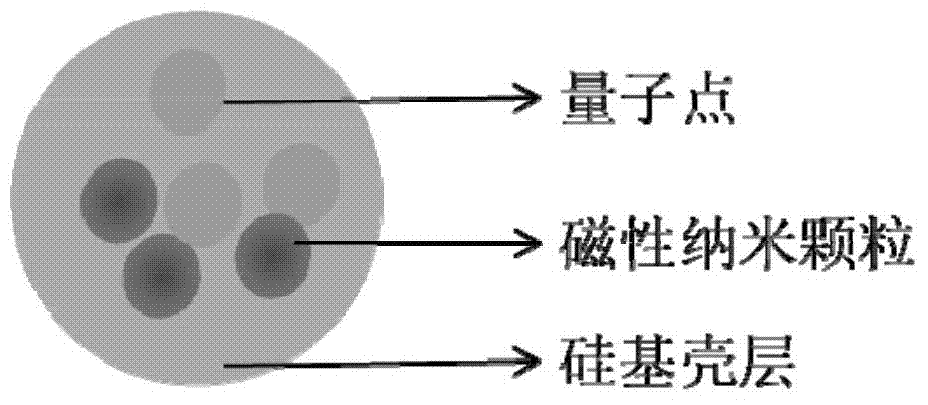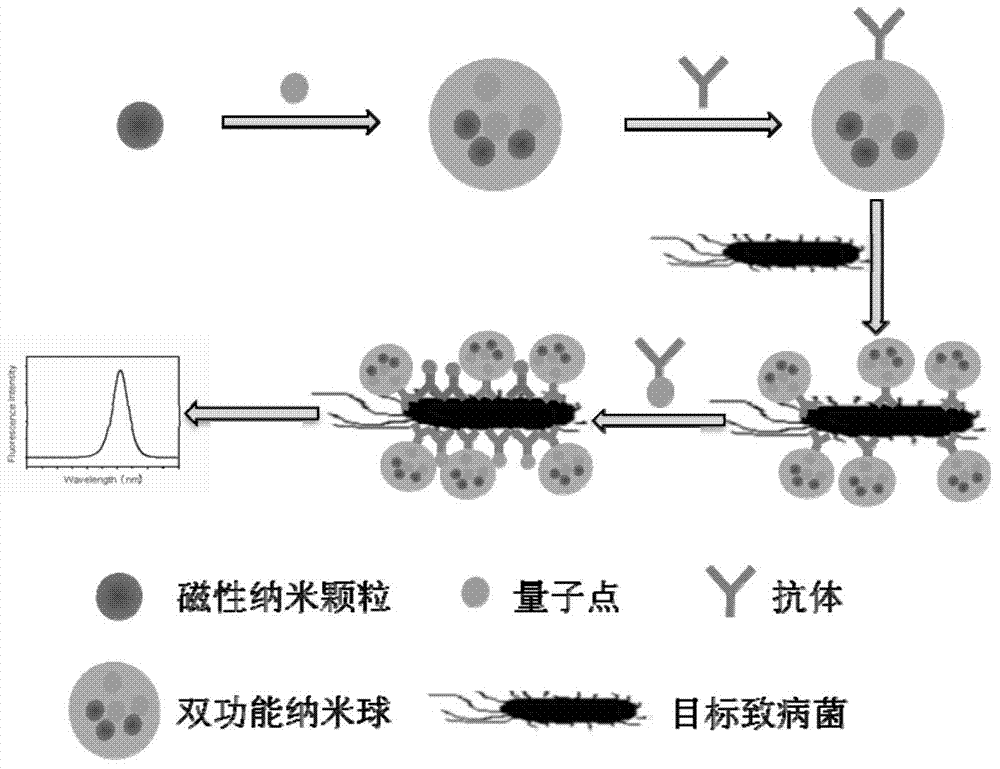Difunctional composite nanosphere and method for rapidly detecting food-borne pathogenic bacteria
A nanosphere, dual-function technology, applied in nanotechnology, nanotechnology, nanotechnology for sensing, etc., can solve the problems of inability to meet the urgent needs of rapid on-site detection of microorganisms, time-consuming, and complicated steps.
- Summary
- Abstract
- Description
- Claims
- Application Information
AI Technical Summary
Problems solved by technology
Method used
Image
Examples
Embodiment 1
[0031] Embodiment 1: the preparation of bifunctional nanosphere
[0032] In the present invention, the bifunctional nanosphere is improved by obtained by the method. Specifically, it is obtained by hydrolyzing ethyl orthosilicate in ethanol solution under the catalysis of a certain concentration of ammonia water. By adjusting the relative concentrations of ammonia, tetraethyl orthosilicate, ethanol, water, magnetic nanoparticles, and quantum dots, the properties and sizes of the bifunctional nanospheres can be changed. A typical synthesis process is as follows:
[0033] Mix 24.75mL water, 16.25mL ethanol and 9.0mL ammonia water thoroughly, then add 20μL magnetic iron oxide nanoparticles and 20μL cadmium telluride quantum dots, then quickly add the mixed solution of 4.5mL tetraethyl orthosilicate and 45.5mL ethanol, and stir the reaction After 2 hours, nanospheres are formed. Through magnetic separation and ethanol washing three times, and vacuum drying overnight, bifuncti...
Embodiment 2
[0034] Embodiment 2: the construction of immune bifunctional silicon-based nanosphere probe
[0035] Firstly, the surface of the bifunctional composite nanospheres prepared in Example 1 was modified. Specifically, 0.5 g of nanospheres were dissolved in 50 mL of pyridine, 0.2 g of succinic anhydride and 0.02 g of 4-dimethylaminopyridine were added, stirred overnight at room temperature, and magnetically separated , washed twice with methanol and water, respectively.
[0036] Then enterohemorrhagic Escherichia coli (E.coli O157:H7) antibody is covalently linked to bifunctional nanospheres, and the operation steps are as follows:
[0037] Take 500μg of nanospheres in a 1.5mL centrifuge tube, add 1mL of washing buffer, mix well and wash thoroughly, magnetically separate and wash twice, resuspend in 250μL of 2-(N-morpholino)ethanesulfonic acid, and then add 500μg1 -Ethyl-3-(3-dimethylaminopropyl)-carbodiimide and 750 μg N-hydroxysuccinimide, activated at 37°C for 15 minutes, then wa...
Embodiment 3
[0038] Embodiment 3: the construction of immune quantum dot probe
[0039] Take 500 μL of quantum dots in a 1.5 mL centrifuge tube, add 1 mL of washing buffer, mix well and wash thoroughly, centrifuge and wash twice, resuspend in 250 μL 2-(N-morpholino)ethanesulfonic acid, and then add 500 μg1 -Ethyl-3-(3-dimethylaminopropyl)-carbodiimide and 750 μg N-hydroxysuccinimide, activated at 37°C for 15 minutes, then washed twice with MES, resuspended and added 50 μg of The antibody was reacted at room temperature for 2 hours, and the antibody was coupled to the surface of the nanosphere to obtain the immune nanosphere. Wash the coupled magnetic beads twice with PBS, add 50 μL of phosphate buffered saline (pH=7.4) containing 1% bovine serum albumin, and store in a 4°C refrigerator until use.
PUM
 Login to View More
Login to View More Abstract
Description
Claims
Application Information
 Login to View More
Login to View More - R&D
- Intellectual Property
- Life Sciences
- Materials
- Tech Scout
- Unparalleled Data Quality
- Higher Quality Content
- 60% Fewer Hallucinations
Browse by: Latest US Patents, China's latest patents, Technical Efficacy Thesaurus, Application Domain, Technology Topic, Popular Technical Reports.
© 2025 PatSnap. All rights reserved.Legal|Privacy policy|Modern Slavery Act Transparency Statement|Sitemap|About US| Contact US: help@patsnap.com


